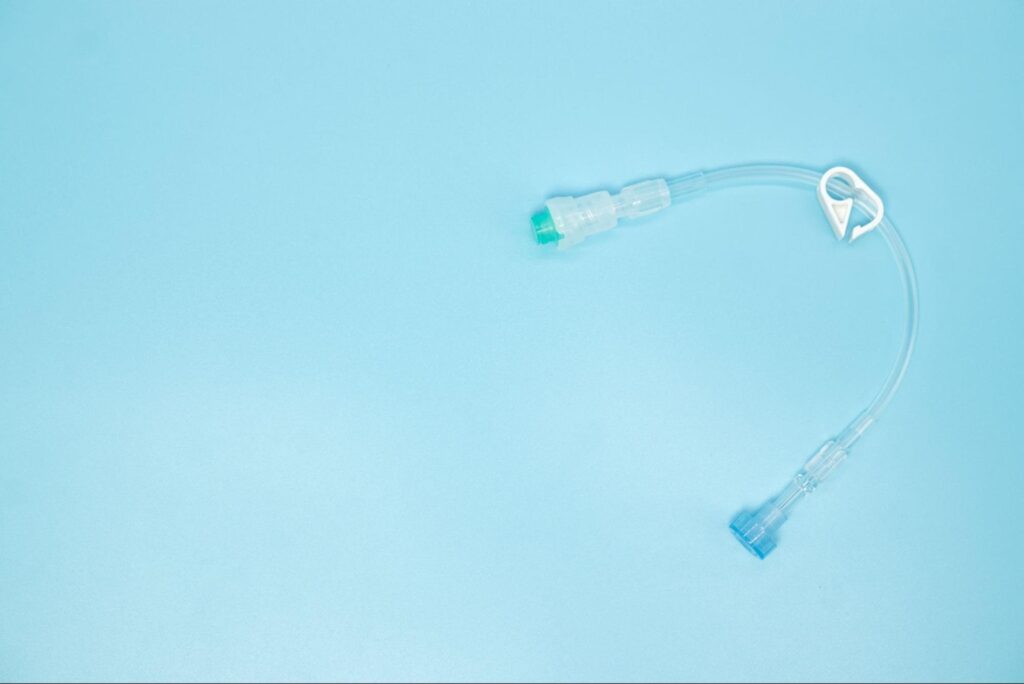IV therapy provides patients with plenty of health and wellness benefits. If you have received IV treatments previously, you may have noticed that there are several pieces of equipment involved, including IV tubing. But what is IV tubing, exactly?
IV tubing is how the healthcare providers administer the treatment to the patients. So, let’s dive in and explore the topic better!

Source: shutterstock.com / Photo Contributor: Numstocker
IV Tubing Definition: What is IV Tubing?
IV tubing (intravenous line) refers to the soft plastic line that runs from the IV bag to the IV catheter. IV tubing is a crucial part of IV treatments as it is through this line that the patients get their medications or IV therapy.
The IV tubing comes separately and is not connected to the IV bag. This ensures they are sterile, and the health providers can choose the appropriate set for their patients.
IV tubing sets are essential for controlled medication and IV fluids administration. The IV tubing connects the medication to the needle the nurse injects into the patient’s arm.
Based on your needs and the treatment you receive, our nurse will use the appropriate IV tubing for your Arizona IV therapy. IV tubing comes in several types.
Components of IV Tubing
IV tubing sets consist of several components that ensure safe and controlled IV therapy administration. IV tubing components are the following:
Sterile spike and spike cap– the spike must be kept sterile as the nurse spikes the IV bag to ensure the patient’s safety
Drip chamber– with the drip chamber, the air rises from the IV fluid, ensuring it is not passed onto the patient
Roller flow control clamp– this component provides control over the administration flow speed. The roller control clamp can also be used to stop the infusion.
Access ports– the access ports on the IV set allow IV push medications to be administered. Access ports are also referred to as Y ports.
Types of IV Tubing
Let’s have a look at all the different types of IV tubing:
Macro drip tubing
Macro drip tubing uses a wider tube to administer IV fluids by producing larger drops. These tubing sets are suitable for delivering higher doses of liquids.
Healthcare providers use macro drip tubing when administering routine IV fluids containing no sensitive medication. Macro drip tubing sets are available in three sizes, including 10 gtt/mL, 15 gtt/mL, and 20 gtt/mL.
They are most suitable when medical teams need to infuse significant fluid volumes, like a saline solution. Macro drips are appropriate in the following cases:
Fluid deficit replenishment
Replacing loss of fluid during operation
To infuse intravenous medication and anesthetics
Micro drip tubing
Unlike macro drips, micro drip tubing sets are narrower than macro drips and provide smaller drops. Micro drip tubing is suitable for infusing sensitive medication where the flow rate is crucial.
Micro drip tubings are available in only one size, 60 gtt/mL, translating to 60 drips per minute. This makes micro drip tubing ideal for drip rates that need to be exact. Healthcare providers use micro drips when an IV administration requires precision.
Extension tubing
Inserting a cannula in a patient’s peripheral vein necessitates extension tubing. Connected to the hub on the cannula, the extension tube is flushed with normal saline to maintain the cannula’s patency.
Extension tubing is present on most peripheral IV cannulas. The tube is about 20 cm long with a positive displacement pressure cap attached to the hub of the cannula. This is for easy access and to reduce catheter hub manipulation.
Healthcare providers must change the extension tubing each time they change the peripheral catheter.
How IV Tubing Works
IV tubing is how essential IV fluids for patient treatment are administered directly into the bloodstream. Only certified medical professionals should handle and place IV tubing drips.
During IV tubing placement, the nurse should do the following:
Start by finding a vein for the IV
Once your nurse find a vein, tie a wide elastic band above it
Next, clean and disinfect the site where the IV will go in
Insert a thin plastic tube into the vein using a needle
After inserting the plastic tube, remove the needle, leaving the tube in place
As the last step, tape the tube to the patient’s arm to hold it securely in place

Source: shutterstock.com/ Photo Contributor: Numstocker
Maintenance and Care of IV Tubing
Healthcare providers must maintain proper hygiene before administering IV therapy. Safety also includes sterilizing and disinfection of the medical instruments, including the IV tubing.
It is also vital that the nurse check the fluid type and its expiration date to verify its safety. Another crucial step before administering an IV is to check the IV bag is intact and not leaking.
It is crucial to keep in mind that IV tubing requires routine replacement to prevent potential infections. Depending on the type of IV tubing, the replacement times should be:
Every 6 to 12 hours, tubing is used to infuse propofol.
Every 72 hours, tubing is used to infuse dextrose and amino acids-containing solutions without lipids.
Every 96 hours for every other type of tubing.
One-time use per patient in the mobile IV therapy setting.
During the administration of the IV, the nurse should closely monitor the patient. They should inspect the infusion site for redness, swelling, or tenderness. These symptoms may be signs of inflammation, irritation, or infection.
Conclusion
What is IV tubing? As we mentioned, IV tubing is an essential part of the IV infusion equipment through which the health providers administer the fluids to the patients.
The macro, micro, and extension drip tubings are among the most popular for the administration of IV therapy. Safety and hygiene standards are of utmost importance when administering IV tubings.




